New 1,2,3-Triazoles from (R)-Carvone: Synthesis, DFT Mechanistic Study and In Vitro Cytotoxic Evaluation
Abstract
:1. Introduction
2. Result and Discussion
2.1. Chemistry
2.2. Theoretical Results and Discussion
2.2.1. Analysis of the DFT Reactivity Indices
2.2.2. Uncatalyzed Reaction of 7 and 8a
2.2.3. Cu(I)-Catalyzed Reaction of 7 and 8a
2.3. Anticancer Activity
3. Conclusions
4. Experimental Section
4.1. Materials and Methods
4.2. Computational Treatment: Calculations
4.3. Cell Culture
4.4. Cytotoxicity Assay
4.5. General Procedure for the Preparation of (R)-Carvon-Alkyne 7
4.6. General Procedure for the Preparation of Carvone-1,2,3-Triazole 9a–h
Supplementary Materials
Author Contributions
Funding
Data Availability Statement
Conflicts of Interest
Sample Availability
References
- Liqiao, S.; Rui, H.; Yanhong, W.; Ying, L.; Ziwen, Y.; Shaoyong, K.; Shi, L.; Hu, R.; Wei, Y.; Liang, Y.; et al. Anthranilic Acid-Based Diamides Derivatives Incorporating Aryl-Isoxazoline Pharmacophore as Potential Anticancer Agents: Design, Synthesis and Biological Evaluation. Eur. J. Med. Chem. 2012, 54, 549–556. [Google Scholar] [CrossRef]
- Yuri, L. What Are the Hallmarks of Cancer? Nat. Rev. Cancer 2010, 10, 232–233. [Google Scholar] [CrossRef]
- Govind, P. Malnutrition leading to cancer by some environmental hazard. IJRAP 2010, 1, 287–291. Available online: www.ijrap.Net (accessed on 1 September 2021).
- Yaremenko, I.A.; Syroeshkin, M.A.; Levitsky, D.O.; Fleury, F.; Terent’ev, A.O. Cyclic Peroxides as Promising Anticancer Agents: In Vitro Cytotoxicity Study of Synthetic Ozonides and Tetraoxanes on Human Prostate Cancer Cell Lines. Med. Chem. Res. 2017, 26, 170–179. [Google Scholar] [CrossRef]
- Zhou, Y.; Li, W.; Xiao, Y. Profiling of Multiple Targets of Artemisinin Activated by Hemin in Cancer Cell Proteome. ACS Chem. Biol. 2016, 11, 882–888. [Google Scholar] [CrossRef] [PubMed]
- Jinwoong, K.; Eun, J.P. Cytotoxic Anticancer Candidates from Natural Resources. Curr. Med. Chem. Anti-Cancer Agents 2002, 2, 485–537. [Google Scholar] [CrossRef] [Green Version]
- Sarfaraj, H.M.d.; Sheeba, F.; Saba, A.; Khan, M.S. Marine Natural Products: A Lead for Anti-Cancer. IJMS 2012, 41, 27–39. [Google Scholar]
- Vishnu, J.R.; Seema, K. Natural Products of Plant Origin as Anticancer Agents. Drug News Perspect. 2001, 14, 465–482. [Google Scholar] [CrossRef]
- Karina, P.; Jean-Francois, B. Marine Natural Products and Related Compounds as Anticancer Agents: An Overview of Their Clinical Status. Anticancer Agents Med. Chem. 2013, 13, 603–631. [Google Scholar] [CrossRef]
- Cordero, C.M.; León-González, A.J.; Montaño, J.M.C.; Morón, E.B.; Lopez-Lazaro, M. Pro-Oxidant Natural Products as Anticancer Agents. Curr. Drug Targets 2012, 13, 1006–1028. [Google Scholar] [CrossRef]
- Ding, Y.; Guo, H.; Ge, W.; Chen, X.; Li, S.; Wang, M.; Chen, Y.; Zhang, Q. Copper(I) Oxide Nanoparticles Catalyzed Click Chemistry Based Synthesis of Melampomagnolide B-Triazole Conjugates and Their Anti-Cancer Activities. Eur. J. Med. Chem. 2018, 156, 216–229. [Google Scholar] [CrossRef]
- Yu, H.; Hou, Z.; Tian, Y.; Mou, Y.; Guo, C. Design, Synthesis, Cytotoxicity and Mechanism of Novel Dihydroartemisinin-Coumarin Hybrids as Potential Anti-Cancer Agents. Eur. J. Med. Chem. 2018, 151, 434–449. [Google Scholar] [CrossRef] [PubMed]
- Odds, F.C.; Brown, A.J.P.; Gow, N.A.R. Antifungal Agents: Mechanisms of Action. Trends Microbiol. 2003, 11, 272–279. [Google Scholar] [CrossRef]
- Kale, P.; Johnson, L.B. Second-Generation Azole Antifungal Agents. Drugs Today 2005, 41, 91–105. [Google Scholar] [CrossRef]
- Geisler, J.; Lønning, P.E. Endocrine Effects of Aromatase Inhibitors and Inactivators in Vivo: Review of Data and Method Limitations. J. Steroid Biochem. Mol. Biol. 2005, 95, 75–81. [Google Scholar] [CrossRef]
- Kim, D.-K.; Kim, J.; Park, H.-J. Synthesis and Biological Evaluation of Novel 2-Pyridinyl-[1,2,3]Triazoles as Inhibitors of Transforming Growth Factor Β1 Type 1 Receptor. Bioorg. Med. Chem. Lett. 2004, 14, 2401–2405. [Google Scholar] [CrossRef]
- Whiting, M.; Tripp, J.C.; Lin, Y.-C.; Lindstrom, W.; Olson, A.J.; Elder, J.H.; Sharpless, K.B.; Fokin, V.V. Rapid Discovery and Structure-Activity Profiling of Novel Inhibitors of Human Immunodeficiency Virus Type 1 Protease Enabled by the Copper(I)-Catalyzed Synthesis of 1,2,3-Triazoles and Their Further Functionalization. J. Med. Chem. 2006, 49, 7697–7710. [Google Scholar] [CrossRef]
- Howell, A.; Buzdar, A. Are aromatase inhibitors superior to antiestrogens? J. Steroid Biochem. Mol. Biol. 2005, 93, 237–247. [Google Scholar] [CrossRef]
- Tian, Y.; Liang, Z.; Xu, H.; Mou, Y.; Guo, C. Design, Synthesis and Cytotoxicity of Novel Dihydroartemisinin-Coumarin Hybrids via Click Chemistry. Molecules 2016, 21, 758. [Google Scholar] [CrossRef] [Green Version]
- Sampad, J.; Shabina, I.; Joice, T.; Sandra, L.; Wim, D. Synthesis and Anticancer Activity of Novel Aza-Artemisinin Derivatives. Bioorg. Med. Chem. 2017, 25, 3671–3676. [Google Scholar] [CrossRef]
- Agalave, S.; Maujan, S.R.; Pore, V.S. Click Chemistry: 1,2,3-Triazoles as Pharmacophores. Chem. Asian J. 2011, 6, 2696–2718. [Google Scholar] [CrossRef]
- Yin, L.; Hu, Q.; Hartmann, R.W. Recent Progress in Pharmaceutical Therapies for Castration-Resistant Prostate Cancer. Int. J. Mol. Sci. 2013, 14, 13958–13978. [Google Scholar] [CrossRef] [Green Version]
- Guo, L.; Ye, C.; Chen, W.; Ye, H.; Zheng, R.; Li, J.; Yang, H.; Yu, X.; Zhang, D. Anti-Inflammatory and Analgesic Potency of Carboxyamidotriazole, a Tumorostatic Agent. J. Pharmcol. Ther. 2008, 325, 10–16. [Google Scholar] [CrossRef] [PubMed] [Green Version]
- Baccelli, I.; Gareau, Y.; Lehnertz, B.; Gingras, S.; Spinella, J.-F.; Corneau, S.; Mayotte, N.; Girard, S.; Frechette, M.; Blouin-Chagnon, V.; et al. Mubritinib Targets the Electron Transport Chain Complex I and Reveals the Landscape of OXPHOS Dependency in Acute Myeloid Leukemia. Cancer Cell 2019, 36, 84–99.e8. [Google Scholar] [CrossRef]
- Tron, G.C.; Pirali, T.; Billington, R.A.; Canonico, P.L.; Sorba, G.; Genazzani, A.A. Click Chemistry Reactions in Medicinal Chemistry: Applications of the 1,3-Dipolar Cycloaddition between Azides and Alkynes. Med. Res. Rev. 2008, 28, 278–308. [Google Scholar] [CrossRef] [PubMed]
- Whiting, M.; Muldoon, J.; Lin, Y.-C.; Silverman, S.M.; Lindstrom, W.; Olson, A.J.; Kolb, H.C.; Finn, M.G.; Sharpless, K.B.; Elder, J.H.; et al. Inhibitors of HIV-1 Protease by Using In Situ Click Chemistry. Angew. Chem. Int. Ed. 2006, 45, 1435–1439. [Google Scholar] [CrossRef]
- Horne, W.S.; Yadav, M.K.; Stout, C.D.; Ghadiri, M.R. Heterocyclic Peptide Backbone Modifications in an Alpha-Helical Coiled Coil. J. Am. Chem. Soc. 2004, 126, 15366–15367. [Google Scholar] [CrossRef] [PubMed] [Green Version]
- Huisgen, R. Cycloadditions—Definition, Classification, and Characterization. Angew. Chem. Int. Ed. Engl. 1968, 7, 321–328. [Google Scholar] [CrossRef]
- Kolb, H.C.; Finn, M.G.; Sharpless, K.B. Click Chemistry: Diverse Chemical Function from a Few Good Reactions. Angew. Chem. Int. Ed. Engl. 2001, 40, 2004–2021. [Google Scholar] [CrossRef]
- Bimoussa, A.; Oubella, A.; Hachim, M.E.; Fawzi, M.; Itto, M.Y.A.; Mentre, O.; Ketatni, E.M.; Bahsis, L.; Morjani, H.; Auhmani, A. New enaminone sesquiterpenic: TiCl4-catalyzed synthesis, spectral characterization, crystal structure, Hirshfeld surface analysis, DFT studies and cytotoxic activity. J. Mol. Struct. 2021, 1241, 130622. [Google Scholar] [CrossRef]
- Laamari, Y.; Oubella, A.; Bimoussa, A.; El Mansouri, A.-E.; Ketatni, E.M.; Mentre, O.; AitItto, M.Y.; Morjani, H.; Khouili, M.; Auhmani, A. Design, Hemiysnthesis, Crystal Structure and Anticancer activity of 1,2,3-Triazoles derivatives of Totarol. Bioorg. Chem. 2021, 115, 105165. [Google Scholar] [CrossRef] [PubMed]
- Fawzi, M.; Laamari, Y.; Koumya, Y.; Oubella, A.; Auhmani, A.; Itto, M.Y.A.; Abouelfida, A.; Riahi, A.; Auhmani, A. Electrochemical and theoretical studies on the corrosion inhibition performance of some synthesized D-Limonene based heterocyclic compounds. J. Mol. Struct. 2021, 1244, 130957. [Google Scholar] [CrossRef]
- Oubella, A.; Itto, M.Y.A.; Auhmani, A.; Riahi, A.; Robert, A.; Daran, J.-C.; Morjani, H.; Parish, C.; Esseffar, M. Diastereoselective synthesis and cytotoxic evaluation of new isoxazoles and pyrazoles with monoterpenic skeleton. J. Mol. Struct. 2019, 1198, 126924. [Google Scholar] [CrossRef]
- Ríos-Gutiérrez, M.; Domingo, L.R.; Esseffar, M.; Oubella, A.; AitItto, M.Y. Unveiling the Different Chemical Reactivity of Diphenyl Nitrilimine and Phenyl Nitrile Oxide in [3+2] Cycloaddition Reactions with (R)-Carvone through the Molecular Electron Density Theory. Molecules 2020, 25, 1085. [Google Scholar] [CrossRef] [PubMed] [Green Version]
- Oubella, A.; AitItto, M.Y.; Auhmani, A.; Riahi, A.; Daran, J.-C.; Auhmani, A. Crystal Structure of (R)-5-[(R)-3-(4-Chlorophenyl)-5-Methyl-4,5-Dihydroisoxazol-5-Yl]-2-Methylcyclohex-2-Enone. Acta Cryst. E. 2020, 76, 400–403. [Google Scholar] [CrossRef] [Green Version]
- Oubella, A.; Fawzi, M.; Auhmani, A.; Riahi, A.; Morjani, H.; Robert, A.; Itto, M.Y.A. Synthesis and Antitumor Activity of Novel Heterocyclic Systems with Monoterpenic Skeleton Combining Dichlorocyclopropane and 1,3,4-Thiadiazole Nucleus. ChemistrySelect 2020, 5, 6403–6406. [Google Scholar] [CrossRef]
- Hachim, M.E.; Oubella, A.; Byadi, S.; Fawzi, M.; Laamari, Y.; Bahsis, L.; Aboulmouhajir, A.; Morjani, H.; Auhmani, A.; AitItto, M.Y. Newly synthesized (R)-carvone-derived 1,2,3-triazoles: Structural, mechanistic, cytotoxic and molecular docking studies. J. Biomol. Stru. Dynam. 2021, 1–14. [Google Scholar] [CrossRef]
- Taia, A.; Essaber, M.; Oubella, A.; Aatif, A.; Bodiguel, J.; Jamart-Grégoire, B.; AitItto, M.Y.; Morjani, H. Synthesis, Characterization, and Biological Evaluation of New Heterocyclic Systems 1,2,3-Triazole-Isoxazoline from Eugenol by the Mixed Condensation Reactions. Synth. Commun. 2020, 50, 2052–2065. [Google Scholar] [CrossRef]
- Oubella, A.; El Mansouri, A.-E.; Fawzi, M.; Bimoussa, A.; Laamari, Y.; Auhmani, A.; Morjani, H.; Robert, A.; Riahi, A.; Itto, M.Y.A. Thiazolidinone-linked 1,2,3-triazoles with monoterpenic skeleton as new potential anticancer agents: Design, synthesis and molecular docking studies. Bioorg. Chem. 2021, 115, 105184. [Google Scholar] [CrossRef]
- Strub, D.J.; Kula, J.; Sikora, M.; Gibka, J.; Lochyński, S. Synthesis and olfactory evaluation of homologous series of (+)- and (−)-carvone oxime ethers. Flavour Fragr. J. 2015, 31, 81–86. [Google Scholar] [CrossRef]
- Allam, M.; Bhavani, A.K.D.; Mudiraj, A.; Ranjan, N.; Thippana, M.; Babu, P.P. Synthesis of Pyrazolo[3,4-d]Pyrimidin-4(5H)-Ones Tethered to 1,2,3-Triazoles and Their Evaluation as Potential Anticancer Agents. Eur. J. Med. Chem. 2018, 156, 43–52. [Google Scholar] [CrossRef] [PubMed]
- Myznikov, L.; Vorona, S.; Artamonova, T.; Zevatskii, Y. An Improved Protocol for the Preparation of 5-Substituted Tetrazoles from Organic Thiocyanates and Nitriles. Synthesis 2014, 46, 781–786. [Google Scholar] [CrossRef]
- Fantauzzi, S.; Gallo, E.; Caselli, A.; Ragaini, F.; Macchi, P.; Casati, N.; Cenini, S. Origin of the Deactivation in Styrene Aziridination by Aryl Azides, Catalyzed by Ruthenium Porphyrin Complexes. Structural Characterization of a Δ2-1,2,3-Triazoline RuII(TPP)CO Complex. Organometallics 2005, 24, 4710–4713. [Google Scholar] [CrossRef]
- Domingo, L.R.; Aurell, M.J.; Pérez, P.; Contreras, R. Quantitative Characterization of the Local Electrophilicity of Organic Molecules. Understanding the Regioselectivity on Diels–Alder Reactions. J. Phys. Chem. A 2002, 106, 6871–6875. [Google Scholar] [CrossRef]
- Pérez, P.; Domingo, L.R.; Aurell, M.J.; Contreras, R. Quantitative Characterization of the Global Electrophilicity Pattern of Some Reagents Involved in 1,3-Dipolar Cycloaddition Reactions. Tetrahedron 2003, 59, 3117–3125. [Google Scholar] [CrossRef]
- Geerlings, P.; De Proft, F.; Langenaeker, W. Conceptual Density Functional Theory. Chem. Rev. 2003, 103, 1793–1874. [Google Scholar] [CrossRef]
- Domingo, L.R.; Ríos-Gutiérrez, M.; Pérez, P. Applications of the Conceptual Density Functional Theory Indices to Organic Chemistry Reactivity. Molecules 2016, 21, 748. [Google Scholar] [CrossRef] [Green Version]
- Domingo, L.R.; Aurell, M.; José, P.P.; Contreras, R. Quantitative Characterization of the Global Electrophilicity Power of Common Diene/Dienophile Pairs in Diels-Alder Reactions. Tetrahedron 2002, 58, 4417–4423. [Google Scholar] [CrossRef]
- Jaramillo, P.; Domingo, L.R..; Eduardo, C.; Patricia, P. A Further Exploration of a Nucleophilicity Index Based on the Gas-Phase Ionization Potentials. J. Mol. Struct. Theochem. 2008, 865, 68–72. [Google Scholar] [CrossRef]
- Saul, P. The Chemistry of the Carbon-Carbon Triple Bond; John Wiley & Sons Ltd.: New York, NY, USA, 1978. [Google Scholar] [CrossRef]
- Tornøe, C.W.; Christensen, C.; Meldal, M. Peptidotriazoles on Solid Phase: [1,2,3]-Triazoles by Regiospecific Copper(I)-Catalyzed 1,3-Dipolar Cycloadditions of Terminal Alkynes to Azides. J. Org. Chem. 2002, 67, 3057–3064. [Google Scholar] [CrossRef]
- Himo, F.; Lovell, T.; Hilgraf, R.; Rostovtsev, V.V.; Noodleman, L.; Sharpless, K.B.; Fokin, V.V. Copper(I)-Catalyzed Synthesis of Azoles. DFT Study Predicts Unprecedented Reactivity and Intermediates. J. Am. Chem. Soc. 2005, 127, 210–216. [Google Scholar] [CrossRef]
- Rodionov, V.O.; Fokin, V.V.; Finn, M.G. Mechanism of the Ligand-Free CuI-Catalyzed Azide–Alkyne Cycloaddition Reaction. Angew. Chem. Int. Ed. 2005, 44, 2210–2215. [Google Scholar] [CrossRef]
- Rodionov, V.O.; Presolski, S.I.; Díaz, D.D.; Fokin, V.V.; Finn, M.G. Ligand-Accelerated Cu-Catalyzed Azide-Alkyne Cycloaddition: A Mechanistic Report. J. Am. Chem. Soc. 2007, 129, 12705–12712. [Google Scholar] [CrossRef]
- Kuang, G.-C.; Guha, P.M.; Brotherton, W.S.; Simmons, J.T.; Stankee, L.A.; Nguyen, B.T.; Clark, R.J.; Zhu, L. Experimental Investigation on the Mechanism of Chelation-Assisted, Copper(II) Acetate-Accelerated Azide–Alkyne Cycloaddition. J. Am. Chem. Soc. 2011, 133, 13984–14001. [Google Scholar] [CrossRef] [Green Version]
- Straub, B.F. Μ-Acetylide µ-Alkenylidene Ligands in “Click” Triazole Syntheses. Chem. Commun. 2007, 37, 3868–3870. [Google Scholar] [CrossRef]
- Ahlquist, M.; Fokin, V.V. Enhanced Reactivity of DinuclearCopper(I) Acetylides in Dipolar Cycloadditions. Organometallics 2007, 26, 4389–4391. [Google Scholar] [CrossRef]
- Kenkichi, S.; Yasuo, T.; Nobue, H. A convenient synthesis of acetylenes: Catalytic substitutions of acetylenic hydrogen with bromoalkenes, iodoarenes and bromopyridines. Tetrahedron Lett. 1975, 16, 4467–4470. [Google Scholar] [CrossRef]
- Nolte, C.; Mayer, P.; Straub, B.F. Isolation of a Copper(I) Triazolide: A “Click” Intermediate. Angew. Chem. Int. Ed. Engl. 2007, 46, 2101–2103. [Google Scholar] [CrossRef]
- Ozkilic, Y.; Tuzun, N.S. A DFT Study on the Binuclear CuAAC Reaction: Mechanism in Light of New Experiments. Organometallics 2016, 35, 2589–2599. [Google Scholar] [CrossRef]
- EL Mansouri, A.; Oubella, A.; Mehdi, A.; AitItto, M.Y.; Zahouily, M.; Morjani, H.; Lazrek, H.B. Design, Synthesis, Biological Evaluation and Molecular Docking of New 1,3,4-Oxadiazole Homonucleosides and Their Double-Headed Analogs as Antitumor Agents. Bioorg. Chem. 2021, 108, 104558. [Google Scholar] [CrossRef]
- El Mansouri, A.; Oubella, A.; Dânoun, K.; Ahmad, M.; Neyts, J.; Jochmans, D.; Snoeck, R.; Andrei, G.; Morjani, H.; Zahouily, M.; et al. Discovery of novel furo[2,3-d]pyrimidin-2-one-1,3,4-oxadiazole hybrid derivatives as dual antiviral and anticancer agents that induce apoptosis. Arch. Pharm. 2021, 354, e210014. [Google Scholar] [CrossRef]
- El Mansouri, A.-E.; Oubella, A.; Maatallahd, M.; AitItto, M.Y.; Zahouily, M.; Morjani, H.; Lazrek, H.B. Design, synthesis, biological evaluation and molecular docking of new uracil analogs-1,2,4-oxadiazole hybrids as potential anticancer agents. Bioorg. Med. Chem. Lett. 2020, 30, 127438. [Google Scholar] [CrossRef]
- Ashwini, N.; Garg, M.; Mohan, C.D.; Fuchs, J.E.; Rangappa, S.; Anusha, S.; Swaroop, T.R.; Rakesh, K.S.; Kanojia, D.; Madan, V.; et al. Synthesis of 1,2-Benzisoxazole Tethered 1,2,3-Triazoles That Exhibit Anticancer Activity in Acute Myeloid Leukemia Cell Lines by Inhibiting Histone Deacetylases, and Inducing P21 and Tubulin Acetylation. Bioorg. Med. Chem. 2015, 23, 6157–6165. [Google Scholar] [CrossRef]
- Frisch, M.J.; Trucks, G.W.; Schlegel, H.B.; Scuseria, G.E.; Robb, M.A.; Cheeseman, J.R.; Scalmani, G.; Barone, V.; Mennucci, B.; Petersson, G.A.; et al. Gaussian 09; Revision A.02; Gaussian: Wallingford, CT, USA, 2009. [Google Scholar]
- Becke, A.D. Density-functional Thermochemistry. III. The Role of Exact Exchange. J. Chem. Phys. 1993, 98, 5648–5652. [Google Scholar] [CrossRef] [Green Version]
- Lee, C.; Yang, W.; Parr, R.G. Development of the Colle-Salvetti Correlation-Energy Formula into a Functional of the Electron Density. Phys. Rev. B. 1988, 37, 785–789. [Google Scholar] [CrossRef] [Green Version]
- Wiberg, K.B. Ab Initio Molecular Orbital Theory by W. J. Hehre, L. Radom, P. v. R. Schleyer, and J. A. Pople, John Wiley, New York, 548pp. J. Comput. Chem. 1986, 7, 379. [Google Scholar] [CrossRef]
- Schlegel, H.B. Optimization of equilibrium geometries and transition structures. J. Comput. Chem. 1982, 3, 214–218. [Google Scholar] [CrossRef]
- Yarkony, D.R. Modern Electronic Structure Theory (In 2 Parts)—Part 1; World Scientific: Singapore, 1995. [Google Scholar] [CrossRef]
- Fukui, K. Formulation of the Reaction Coordinate. J. Phys. Chem. 1970, 74, 4161–4163. [Google Scholar] [CrossRef]
- Gonzalez, C.; Schlegel, H.B. Reaction Path Following in Mass-Weighted Internal Coordinates. J. Phys. Chem. 1990, 94, 5523–5527. [Google Scholar] [CrossRef]
- Gonzalez, C.; Schlegel, H.B. Improved Algorithms for Reaction Path Following: Higher-order Implicit Algorithms. J. Chem. Phys. 1991, 95, 5853–5860. [Google Scholar] [CrossRef] [Green Version]
- Scott, A.P.; Radom, L. Harmonic Vibrational Frequencies: An Evaluation of Hartree-Fock, Møller-Plesset, Quadratic Configuration Interaction, Density Functional Theory, and Semiempirical Scale Factors. J. Phys. Chem. 1996, 100, 16502–16513. [Google Scholar] [CrossRef]
- Domingo, L.R. A New C–C Bond Formation Model Based on the Quantum Chemical Topology of Electron Density. RSC Adv. 2014, 4, 32415–32428. [Google Scholar] [CrossRef] [Green Version]
- Reed, A.E.; Weinstock, R.B.; Weinhold, F. Natural Population Analysis. J. Chem. Phys. 1985, 83, 735–746. [Google Scholar] [CrossRef]
- Reed, A.E.; Curtiss, L.A.; Weinhold, F. Intermolecular Interactions from a Natural Bond Orbital, Donor-Acceptor Viewpoint. Chem. Rev. 1988, 88, 899–926. [Google Scholar] [CrossRef]
- Robert, G.P.; László, V.S.; Shubin, L. Electrophilicity Index. J. Am. Chem. Soc. 1999, 121, 1922–1924. [Google Scholar] [CrossRef]
- Parr, R.G.; Pearson, R.G. Absolute Hardness: Companion Parameter to Absolute Electronegativity. J. Am. Chem. Soc. 1983, 105, 7512–7516. [Google Scholar] [CrossRef]
- Cossi, M.; Rega, N.; Scalmani, G.; Barone, V. Energies, structures, and electronic properties of molecules in solution with the C-PCM solvation model. J. Comput. Chem. 2003, 24, 669–681. [Google Scholar] [CrossRef] [PubMed]










| Product | Formula | Ar | Yield (%) | [MH]+ (a) | [MH]+ (b) |
|---|---|---|---|---|---|
| 9a | C19H22N4O | C6H5 | 91 | 323.1872 | 323.1873 |
| 9b | C20H24N4O | 4-CH3-C6H4 | 87 | 337.2028 | 337.2031 |
| 9c | C19H21ClN4O | 4-Cl-C6H4 | 92 | 357.1482 | 357.1482 |
| 9d | C19H21N5O3 | 4-NO2-C6H4 | 88 | 368.1723 | 368.1712 |
| 9e | C20H24N4O | 2-CH3-C6H4 | 82 | 337.2028 | 337.2022 |
| 9f | C20H23ClN4O | 2-CH3-4-Cl-C6H3 | 86 | 371.1620 | 371.1629 |
| 9g | C19H21FN4O | 4-F-C6H4 | 94 | 341.1778 | 341.1783 |
| 9h | C20H24N4O | C6H5-CH2 | 89 | 337.2028 | 337.2037 |
| Compound | 9a | 9b | 9c | 9d | 9e | 9f | 9g | 9h |
|---|---|---|---|---|---|---|---|---|
| H-C3= (δ 1H) | 6.02 | 5.96 | 6.01 | 5.96 | 5.95 | 5.94 | 6.08 | 5.99 |
| =C3 (δ 13C) | 132.83 | 132.76 | 132.94 | 133.14 | 132.75 | 130.80 | 132.89 | 132.62 |
| =CH2 (δ1H) | 4.75 | 4.67 | 4.73 | 4,70 | 4.69 | 4.69 | 4.76 | 4.76 |
| =CH2 (δ13C) | 110.17 | 109.94 | 110.37 | 109.99 | 109.96 | 109.97 | 109.96 | 109.91 |
| H-C5′ (δ1H) | 8.00 | 7.90 | 7.90 | 8.35 | 7.70 | 7.68 | 7.95 | 7.50 |
| C5′ (δ13C) | 121.74 | 121.32 | 121.20 | 121.05 | 124,66 | 124.89 | 121.46 | 123.10 |
| C4′ (δ13C) | 145.77 | 145.58 | 146.28 | 147.20 | 144.93 | 145.21 | 145.93 | 145.90 |
| µ | η | ω | N | |
|---|---|---|---|---|
| 8a | −3.62 | 5.16 | 1.27 | 2.92 |
| 7 | −3.34 | 5.22 | 1.07 | 3.17 |
| 2Cu(I)-7 | −6.21 | 4.36 | 4.42 | 0.73 |
| Species | ∆E | ∆H | T∆S | ∆G |
|---|---|---|---|---|
| 8a + 2Cu(I)-7 | 0 | 0 | 0 | 0 |
| 1,4-RC | −15.39 | −14.79 | −0.0175 | −14.77 |
| 1,4-TS1 | −9.92 | −10.34 | −0.0231 | −10.32 |
| 1,4-In | −25.11 | −25.67 | −0.0238 | −25.65 |
| 1,4-TS2 | −11.68 | −12.34 | −0.1013 | −12.24 |
| 1,4-P | −57.29 | −57.71 | −0.1150 | −57.59 |
| 1,5-RC | −17.65 | −16.75 | −0.1006 | −16.65 |
| 1,5-TS1 | 12.46 | 12.71 | −0.1067 | 12.82 |
| 1,5-In | −21.48 | −21.75 | −0.0009 | −21.75 |
| 1,5-TS2 | −18.79 | −19.45 | −0.0094 | −19.44 |
| 1,5-P | −52.37 | −52.78 | −0.1249 | −52.65 |
| Compound | IC50 (µM) | |||
|---|---|---|---|---|
| HT1080 | A-549 | MCF-7 | MDA-MB-231 | |
| 7 | >100 | >100 | >100 | >100 |
| 9a | 85.76 | 71.21 | 55.45 | 72.63 |
| 9b | 51.9 | >100 | 89.75 | >100 |
| 9c | 45.19 | >100 | 25.03 | 37.5 |
| 9d | 25.77 | 30.61 | 27.89 | 45.28 |
| 9e | >100 | >100 | >100 | >100 |
| 9f | >100 | 62.98 | 87.21 | >100 |
| 9g | 30.44 | 51.83 | 30.11 | >100 |
| 9h | 48.69 | >100 | 41.54 | 39.45 |
| Dox | 5.09 | 6.41 | 5.41 | 5.1 |
Publisher’s Note: MDPI stays neutral with regard to jurisdictional claims in published maps and institutional affiliations. |
© 2022 by the authors. Licensee MDPI, Basel, Switzerland. This article is an open access article distributed under the terms and conditions of the Creative Commons Attribution (CC BY) license (https://creativecommons.org/licenses/by/4.0/).
Share and Cite
Oubella, A.; Bimoussa, A.; N’ait Oussidi, A.; Fawzi, M.; Auhmani, A.; Morjani, H.; Riahi, A.; Esseffar, M.; Parish, C.; Ait Itto, M.Y. New 1,2,3-Triazoles from (R)-Carvone: Synthesis, DFT Mechanistic Study and In Vitro Cytotoxic Evaluation. Molecules 2022, 27, 769. https://doi.org/10.3390/molecules27030769
Oubella A, Bimoussa A, N’ait Oussidi A, Fawzi M, Auhmani A, Morjani H, Riahi A, Esseffar M, Parish C, Ait Itto MY. New 1,2,3-Triazoles from (R)-Carvone: Synthesis, DFT Mechanistic Study and In Vitro Cytotoxic Evaluation. Molecules. 2022; 27(3):769. https://doi.org/10.3390/molecules27030769
Chicago/Turabian StyleOubella, Ali, Abdoullah Bimoussa, Abdellah N’ait Oussidi, Mourad Fawzi, Aziz Auhmani, Hamid Morjani, Abdelkhalek Riahi, M’hamed Esseffar, Carol Parish, and Moulay Youssef Ait Itto. 2022. "New 1,2,3-Triazoles from (R)-Carvone: Synthesis, DFT Mechanistic Study and In Vitro Cytotoxic Evaluation" Molecules 27, no. 3: 769. https://doi.org/10.3390/molecules27030769
APA StyleOubella, A., Bimoussa, A., N’ait Oussidi, A., Fawzi, M., Auhmani, A., Morjani, H., Riahi, A., Esseffar, M., Parish, C., & Ait Itto, M. Y. (2022). New 1,2,3-Triazoles from (R)-Carvone: Synthesis, DFT Mechanistic Study and In Vitro Cytotoxic Evaluation. Molecules, 27(3), 769. https://doi.org/10.3390/molecules27030769







